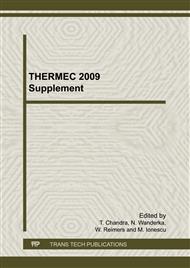[1]
C. Shiga, A. Kamada, T. Hatomura, K. Hirose, J. Junichi, and T. Sekine. Development of large diameter high strength line pipes for low temperature services. Technical Report 4, Kawasaki Steel Technical Report, Kawasaki Steel, Japan, 1981, pp.97-109.
Google Scholar
[2]
J. Q. Wang, A. Atrens, D. R. Cousens, and N. Kinaev: Journal of Materials Science Vol. 34 (1999), p.1721.
Google Scholar
[3]
M. C. Zhao, K. Yang, F. R. Xiao, and Y. Y. Shan: Materials Science & Engineering A Vol. 355 (2003), p.126.
Google Scholar
[4]
E. Treiss: 3R International Vol. 20(11) (1981), p.627.
Google Scholar
[5]
J. G. Williams, C. R. Killmore, F. J. Barbaro, A. Meta, and L. Fletcher, in: Microalloying '95 Conference Proceedings, edited by M. Korchynsky, A. J. DeArdo, P. Repasi, and G. Tither ISS-AIME, Warrendale, Pennsylvania (1995), p.117.
Google Scholar
[6]
C. Yu: Tube International March (1996), p.153.
Google Scholar
[7]
N. Pradhan, N. Banerjee, B. B. Reddy, S. K. Sahay, D. S. Basu, P. K. Bhor, S. Das, and S. Bhattyacharya: Scandinavian Journal of Metallurgy Vol. 34 (2005), p.232.
DOI: 10.1111/j.1600-0692.2005.00721.x
Google Scholar
[8]
J. P. Benedict, R. Anderson, S. J. Klepeis, and M. Chaker, in: volume 199 of Materials Research Society Symposium Proceedings (1990), p.189.
Google Scholar
[9]
J. G. Williams, C. R. Killmore, F. J. Barbaro, J. Piper, and Fletcher: Materials Forum Vol. 20 (1996), p.13.
Google Scholar
[10]
G. R. Speich, L. J. Cuddy, C. R. Gordon, and A. J. DeArdo, in: Phase Transformations in Ferrous Alloys edited by A. R. Marder and J. I. Goldstein, TMS-AIME., Warrendale, Pennsylvania, USA (1984), p.341.
Google Scholar
[11]
I. Tamura: Trans. ISIJ Vol. 27 (1987), p.763.
Google Scholar
[12]
R. L. Bodnar and S. S. Hansen: Metallurgical & Materials Transactions A Vol. 25A (1994), p.665.
Google Scholar
[13]
S. Jones and H. K. D. H. Bhadeshia: Acta Materialia Vol. 45 (1997), p.2911.
Google Scholar
[14]
S. Jones and H. K. D. H. Bhadeshia: Metallurgical & Materials Transactions A Vol. 28A (1997), p. (2005).
Google Scholar
[15]
A. Lambert-Perlade, A. F. Gourgues, and A. Pineau: Acta Materialia Vol. 52 (2004), p.2337.
Google Scholar
[16]
Y. M. Kim, S. Y. Shu, H. Lee, B. Hwang, S. Lee, and N. J. Kim: Metallurgical &Materials Transactions A Vol. 38 (2007), p.1731.
Google Scholar
[17]
S. T. Kimmins and D. J. Gooch: Metal Science Vol. 17 (1983), p.519.
Google Scholar


